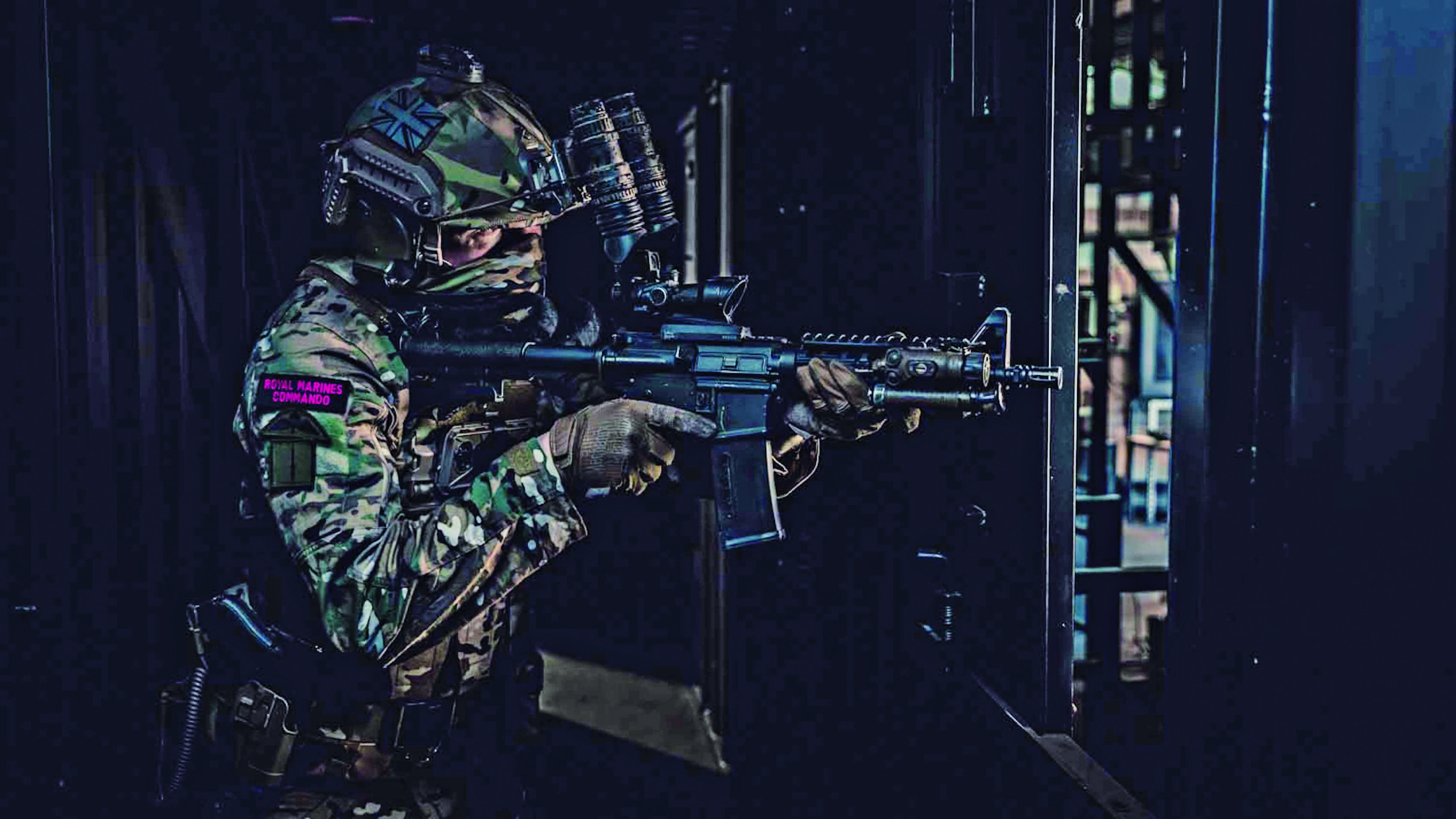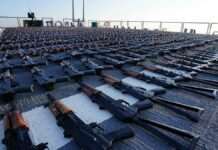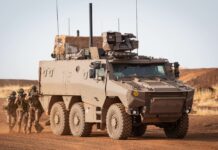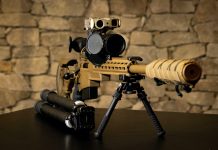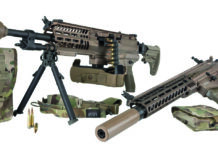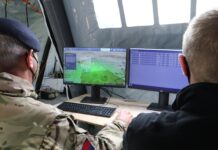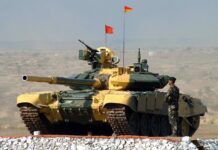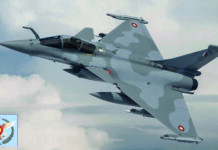There have been immense developments in equipment available to the individual
soldier over the last twenty years.
Some of the more visible developments in newly available military equipment include:
- optical sights on rifles
- night vision goggles
- more effective body armour
- new and improved materials for combat clothing
- personal load carrying equipment that actually works as advertised, and many other enhancements
On the other hand, despite all of these improvements, it’s not a perfect world, something that is particularly true for the infantry soldier who year-on-year is expected to carry more equipment, which equals more weight, and higher risk of injury from being overburdened.
Pistols
For all of the new possibilities that have emerged, other things have remained constant. Surprisingly, one area where this is absolutely true is in the area of small arms, the fundamental tool of the individual soldier. Pistols present an interesting example. There is the M17/M18 Modular Handgun System from SIG Sauer as adopted by the US Army, or the Glock pistols as adopted by the British and French armies, among others. The weapons themselves feature advanced non-traditional materials, but the rounds they fire can certainly be called traditional. These pistols use the NATO standard 9×19 mm round, a round developed by Georg Luger, of Luger pistol fame, back in 1902! That is not to suggest that there is a limited choice of pistol rounds to choose from. On the contrary there are a vast number of different pistol calibres available. The issue is, very few have the longevity demonstrated by the 9×19 mm round.
Rifles
Moving up the scale to the assault rifle, this is a sector that has oscillated between promises of revolutionary change, back to incremental progress or just sticking with the status quo. Yet at this particular point in time, we could have reached a moment where for the first time in many years we could be seeing significant change in the assault rifle sector.
At the same time though, one of the largest-ever orders for a conventional assault rifle for many years has just been placed by India. The path to this massive order unfortunately reflects many of the problems of Indian defence programmes, in that the route to actually placing an order was painfully slow, the process unduly complex, and that the end-user was forced to operate with unsuitable equipment for far too long. Another complicating factor was the sheer size of the Indian Army, with a regular personnel strength of some 1.4 million, with reserves numbering about a million personnel, added to which you have paramilitary forces and the police, all of whom would also acquire the new service rifle. If you are going to end up buying vast numbers of rifles, you need to get it right.
India Decides
Upon independence, India had an indigenous small arms and ammunition manufacturing capability under the Ordnance Factory Board (OFB). The OFB still exists, but in June 2021, the Indian Government decided to amalgamate the 41 production units of the OFB into seven government-owned companies. Of these seven companies, Munitions India Limited supplies small arms ammunition, while Advanced Weapons and Equipment India Limited (AWEIL) is responsible for small arms. Linked to AWEIL is the Indo-Russian Rifles Private Limited, whose role in the Indian small arms story will shortly become clear.
The starting point for the Indian Army small arms sector was that they were equipped with standard pattern British Commonwealth infantry weapons, primarily produced at the Ishapore OFB factory. The key weapons at the time were the Lee Enfield bolt-action battle rifle and the BREN Light Machine Gun, both in .303 (7.7×56 mmR). Later on, both weapons were converted to the 7.62×51 mm NATO calibre, with the BREN still in service, while the Lee Enfield ended up being deployed in large numbers by the Indian Police, with the weapon remaining in production in a sporting rifle variant for the commercial market.
The next step for India was to acquire an automatic rifle and this led them to looking at the Commonwealth version of the FN FAL in the form of the Australian and British L1A1 rifles, as well as the standard FN variant. Ishapore went into production with an Indian variant in the early 1960s, solving licencing problems with FN along the way. Although a substantial number of these 7.62×51 mm battle rifles were produced in India, there were never enough available to meet the totality of the rifle requirement.
A solution to the rifle problem came about as the Soviet Union emerged as a major defence supplier to India from the mid-1960s onwards, as they were able to offer India the direct supply of large numbers of AK-47 and AKM assault rifles in the 7.62×39 mm M43 calibre. Subsequently, AK-type rifles were purchased from Bulgaria and East Germany, as well as Czech Vz.58 rifles in 7.62×39 mm. Following the collapse of the Soviet Union in 1990, India continued to buy AK-type rifles from Bulgaria amongst others, since the Indian military, its Special and Paramilitary forces had an insatiable demand for assault rifles.
Then in the mid-1990s, Ishapore returned to the fray with an indigenous assault rifle in the form of INSAS built specifically to meet an Indian Army requirement for a new assault rifle and light machine gun in 5.56×45 mm M193. Apart from bringing another small arms calibre to the Indian Army to complicate logistics, the INSAS – which became available in the late 1990s – was unfortunately rather dire as a small arms system. Later on, matters improved somewhat and the INSAS managed to become just mediocre! The need to replace the INSAS was recognised pretty early on, but making that a reality would become an immensely difficult and time-consuming task.
In the midst of all of this, India’s defence procurement behaviour changed dramatically, when it suddenly became open to buying equipment from non-traditional suppliers. Another new development was that Indian Special Forces were able to buy weapons that were more suitable for their mission requirements, rather than relying on existing in-service equipment. All of this added up to India becoming a very interesting small arms market. Assault rifles purchased by Indian Special Forces include the IWI TAVOR, the FN SCAR in both 5.56 mm and 7.62 mm NATO, the M4 carbine and reportedly the T91 in 5.56 mm from Taiwan. In addition, pistols, submachine guns, Designated Marksman Rifles (DMR), sniper rifles and LMGs have all been acquired from a variety of sources.
Efforts to develop an indigenous successor to the INSAS that the Indian Army was prepared to accept proved futile, and this led to a situation where a host of competing small arms requirements came to the surface. There were also efforts to upgrade the existing assault rifle inventory, particularly the AK-47/AKM that had been acquired from multiple sources over the years. FAB Defense of Mod’in, Israel, has been involved in a number of AK upgrade programmes in India; amongst the items they supply are new handguards, new magazines, plus M-LOK and Picatinny rail installations. More recently, the company has introduced some upgrade options for the Vz.58. Also providing AK upgrade services is the Indian company, SSS Defence, who received their first contract in 2021; their package includes a new buttstock, rails and a flash suppressor.
Resolving Problems
Apart from keeping much of its existing AK inventory in service, the Indian Army had determined that a single rifle type would not be able to meet its requirements. This then led to a total of three procurement programmes being actioned, one for a carbine, one for a battle rifle and one for an assault rifle. Of these three programmes, two would be successful and one would fail.
Dealing with the programme that failed first, the official name for this effort was the Close-Quarter Carbine. In September 2018, it was announced that Caracal International of the United Arab Emirates (UAE) had won the carbine competition with the CAR 816 5.56×45 mm weapon and that 93,895 rifles would be purchased. Had all gone according to plan, the Indian Army intended to purchase a further tranche of 360,000 carbines. However, the programme stalled in the face of a new policy to locally manufacture weapons and while Caracal did make a proposal for local manufacture, it was not enough and as of September 2020, the carbine programme was halted.
The next Indian Army small arms requirement was for a battle rifle, also classified as a patrol rifle in 7.62×51 mm NATO calibre. Initially, at the beginning of 2018, the overall requirement was for as many as 550,000 rifles. By the end of that year, it had become clear that the SIG Sauer SIG716 had been selected and this was confirmed in February 2019 by a statement from SIG Sauer, who stated that the weapon was an AR platform, featuring a 16-inch barrel, M-LOK handguard and a six-position telescoping stock, in total 72,400 SIG716 rifles were ordered and the weapons were to be built in the US.
Bearing in mind the growing pressure to manufacture locally in India, the fact that the SIG716 was being directly acquired from the US showed the importance attached to this purchase. Another important factor was the ability of SIG Sauer to offer rapid delivery, as it appears that the majority of the first batch of SIG716 were delivered by 2020. The success of the SIG716 resulted in a second order in mid-2020 with 72,000 more rifles being purchased, and again these will be manufactured in the US.
The third major Indian Army small arms contract was for an assault rifle. The outline requirement called for a target acquisition of 750,000 weapons. A major assault rifle programme was going to be difficult enough, but this effort was to be rendered even more complicated as it was to be transacted under an inter-governmental agreement between India and Russia and that, as a part of that agreement, a new manufacturing centre would be established in India to produce the rifles. This centre would come under the control of Indo-Russia Rifles Private Limited (IRRPL), located at Korwa, Amethi District, Uttar Pradesh. Ownership is AWEIL 50.5 per cent, Kalashnikov Concern 42 per cent and Rosoboronexport 7.5 per cent.
The assault rifle under discussion in this context is the AK-203; this is a 7.62×39 mm calibre weapon featuring an accurized barrel, four Picatinny rails on the handguard and a Picatinny rail on the receiver cover. It is understood that disagreements over pricing, among other factors, delayed the resolution of the acquisition programme. Then in August 2021, it was decided that the Indian Army would order 70,000 AK-203 assault rifles, with these being directly supplied from Russia. The rest of the programme was resolved on 6 December 2021, when Indian Defence Minister Rajnath Singh and Russian Defence Minister General Sergei Shoigu, signed an agreement covering the acquisition of 601,427 AK-203 to be manufactured by IRRPL in India.
If one takes a moment, consider the numbers of small arms we have been discussing in the context of India. In early 2018, they were looking at over 450,000 carbines in 5.56×45 mm, 550,000 battle/patrol rifles in 7.62×51 mm and 750,000 assault rifles in 7.62×39 mm. In the end, they have contracted for 144,400 battle/patrol rifles and 671,427 assault rifles, in comparison to when France decided to replace its FAMAS assault rifles under the Arme Individuelle Future (AIF) programme, the French Army (l’armée de Terre) with a purchase announced in September 2016, covered 93,080 Heckler & Koch (HK) HK416F-S/F-C 5.56×45 mm assault rifles, plus an additional 23,920 rifles for the other French services.
This comparison of the French and Indian small arms purchases gives some idea of the magnitude of the Indian acquisition programmes between 2019 and 2021. It’s worth noting one other Indian small arms purchase that was contracted during this time; this was the acquisition of the IWI NEGEV NG7 LMG in 7.62×51 mm calibre. In March 2020, the Indian Ministry of Defence announced the purchase of 16,479 NEGEV NG7, with the acquisition being described as operationally urgent.
The Future Is Now
The US Army has been working towards a revolution in small arms ever since the 1950s. With such programmes as the Special Purpose Infantry Weapon (SPIW), it has spent a considerable amount of money investigating technologies, but thus far with limited results. The Advanced Combat Rifle (ACR) programme of the 1980s led nowhere, as did the Objective Individual Combat Weapon (OICW) programme which was cancelled in 2005. Research continued though via the Lightweight Small Arms Technologies (LSAT) programme and the Cased Telescoped Small Arms Systems (CTSAS) programme.
Then in 2017 things suddenly became interesting in the US small arms scene; in June of that year a solicitation was issued for a new weapon – the Interim Combat Service Rifle (ICSR). ICSR was going to effectively be an off-the-shelf weapon using the M80A1 7.62×51 mm Enhanced Performance Round (EPR) to fill “a potential gap in the capability of ground forces and infantry to penetrate body armour using existing ammunition.” The ICSR solicitation was later withdrawn by the US Army in November 2017, as resources were allocated to a new programme called Next Generation Squad Weapon (NGSW) or to be more precise, the Next Generation Squad Automatic Rifle (NGSAR).
According to US Army Contracting Command: “NGSAR is a single incremental program to meet future force warfighting needs. It is the planned replacement for the M249 Squad Automatic Weapon (SAW) in Brigade Combat Teams (BCT) and select support units during the next decade. It will combine the firepower and range of a machine gun with the precision and ergonomics of a carbine, yielding capability improvements in accuracy, range, and lethality.” NGSAR was progressing quite nicely, until the game changed on 4 October 2018, when a new programme emerged – Next Generation Squad Weapons (NGSW) consisting of “two weapon variants and a common cartridge for both weapons, utilising Government provided 6.8 mm projectiles.” The two weapons are the Next Generation Squad Weapon-Rifle (NGSW-R) and the Next Generation Squad Weapon-Automatic Rifle (NGSW-AR). The NGSW-R is the planned replacement for the M4/M4A1 Carbine and the NGSW-AR is the planned replacement for the M249 SAW.
By August 2019, three companies had been selected for the NGSW programme, these were: SIG Sauer with a complete weapon and ammunition solution, a team led by GD-OTS, including Beretta and True Velocity (responsible for composite-cased ammunition), and a team led by Textron Systems, featuring a case-telescoped round solution, including Heckler & Koch (HK) and Olin Winchester on the ammunition side. Another critical element of the NGSW is the Next Generation Squad Weapons – Fire Control (NGSW-FC) system. After a down-select, two companies were primed to move forward on this element of the programme in the form of L3Harris and Vortex Optics.
With the change of administration in Washington DC in January 2021, there was always the chance that new defence priorities would emerge leading to programme cancellations. Bearing in mind the previous track record of US Army small arms programmes, there was always the chance that NGSW would be cancelled. The way matters have evolved indicates that NGSW is not only surviving, it is making real progress towards being fielded by the US Army.
Winchester operates the government-owned US Army Lake City Army Ammunition Plant in Independence, Missouri. In January, they announced the award of a US$ 20M cost-plus and firm-fixed-price contract covering ammunition development, manufacturing facility requirements analysis and production capacity planning for the 6.8 mm NGSW programme. It should be noted that the three contenders for NGSW are offering three different ammunition solutions, a hybrid cartridge, a composite-cased cartridge and originally a case-telescoped cartridge.
The most significant announcement came on 7 January when the US Army PEO Soldier PM Soldier Lethality announced that the US Army had awarded Vortex Optics with a 10-year firm fixed price, Follow-on Production Other Transaction Agreement (P-OTA) with a maximum ceiling value of US$2.7Bn covering the production and delivery of up to 250,000 XM157 NGSW-FC systems over a 10-year period. These NGSW-FC numbers provide an idea of the target number of NGSW systems to be acquired.
As far as the actual weapons are concerned, the selection timetable had moved to early 2022 and now appears to have shifted again to the middle of 2022. However, there have been significant changes among the contenders for the NGSW system. In April 2021, LoneStar Future Weapons of Garland, Texas, formed a strategic partnership with True Velocity to compete in the NGSW programme, with the press release issued at the time stating that ”Under the arrangement, LoneStar Future Weapons assumed the prime contractor role from General Dynamics Ordnance & Tactical Systems and True Velocity continued to serve as a subcontractor responsible for the provision of its advanced 6.8TVCM composite-cased cartridge.” Then in November 2021, True Velocity announced that they had acquired LoneStar Future Weapons for a consideration of US$84M. It should also be noted that Beretta are still involved in supporting the True Velocity bid.
Outside of the NGSW programme, True Velocity is offering their 6.8TVCM cartridge to other small arms manufacturers. Apart from being part of the team on NGSW, Beretta will be assisting on a version of the True Velocity NGSW for US allies, as well as the development of a semi-automatic version of the weapon for the US commercial market. Other US small arms manufacturers are also set to offer weapons featuring the 6.8TVCM.
This leaves True Velocity and SIG Sauer as contenders for NGSW, but what of the third contender Textron Systems? In their November 2021 release announcing the LoneStar acquisition, True Velocity stated that ”True Velocity and LoneStar Future Weapons are one of two teams remaining in the NGSW programme, which is expected to culminate in January 2022.” There has undoubtedly been much speculation about Textron and NGSW, with little push back from the company. When you consider that Textron had been working on case-telescoped infantry weapons since the LSAT programme had started in 2003, to fall at the last fence prior to the award of the US Army future small arms programme is rather sad.
Solution Search
Clearly if the US Army gets the NGSW into service, that will change the small arms picture, with the first weapons likely to enter service by the end of this year and certainly by next. The 6.8 mm round, whether it be hybrid or composite-cased, will inevitably become the de facto NATO standard. In these circumstances, it would appear prudent to wait to see if the US programme does indeed deliver on its performance promises before embarking on new small arms acquisitions. For some though, there is no point in waiting. At the end of September 2021, the Lithuanian Defence Materiel Agency signed a €19M (VAT not included) contract for the supply of G36 assault rifles from HK. This is G36 order number four by Lithuania since they adopted the G36 as their standard assault rifle in 2007.
Others could have waited to see how the US NGSW effort evolved before taking steps towards new small arms acquisitions, but decided to continue with an acquisition programme anyway. On 17 December 2021, Britain issued an Invitation to Tender (ITT) for the procurement and support of an Armalite Rifle (AR) platform Alternative Individual Weapon (AIW) System for the Army Special Operations Brigade (ASOB). The timetable for the programme is that ITT responses should be received by 4 February, with a contract award on 25 March. As many as six different trial systems could be selected, and contractors could be weapons manufacturers, optics manufacturers or agents representing one or both manufacturers. Trials quantities will range from 88 up 528 AIW systems, with first trials systems to be delivered by the end of August.
After the completion of the trials phase, there will be competitions covering the supply and support of the AIW weapon and the AIW optic, with the support period set at ten years. Depending on the winning bid(s), a single contract could be awarded for the AIW and optics, or separate weapon and optics contracts to either single or multiple contractors. According to the ITT, Full Operational Capability (FOC) will be achieved with 3,000 AIW systems delivered, with the ‘Total Fleet Requirement’ being in the region of 10,000 AIW systems.
The outline technical requirement is that the AIW must be optimised for use with a suppressor and that the AIW rifle system will consist of a rifle plus signature reduction system and an optic system. According to the ITT: “The AIW system will be a 5.56 mm Armalite Rifle (AR) platform, optimised for use with L15A2, a 62gr 5.56×45 mm NATO ball round, equivalent to SS109.” In total, 16 companies were sent the ITT, and potential rifle suppliers were:
- Caracal
- Colt Canada
- Daniel Defense
- HK
- Knight’s Armament Company (KAC)
- SIG Sauer
- Steyr
Potential optic suppliers were:
- Aimpoint
- EOTech
- Holosun
- L3Harris
- Leupold
- Raytheon ELCAN
- Steiner
- Trijicon
- Vortex Optics
The ASOB is a new British Army formation, consisting of four Ranger Battalions and the Joint Counter Terrorist Training and Advisory Team (JCTTAT). According to the British Army: “The Ranger Battalions will have a persistent presence across the world, to operate with allies and partners and to tackle adversaries, wherever they pose a threat to the UK and its interests. Ranger Battalions and JCTTAT are optimised to operate alongside selected specialised Partner Forces in complex, high threat environments to counter threats posed by Violent Extremist Organisations (VEO).”
The fact that ASOB is going its own way in small arms with the AIW system is not an unusual development in terms of recent British military practice, as evidenced by the Royal Marines in terms of both combat clothing and small arms. Back in the late 1960s, Britain introduced its Disruptive Pattern Material (DPM) camouflage system, which went through various iterations and remained in service until replaced by the Multi-Terrain Pattern (MTP) from 2010 onwards. Like the Army, the Royal Marines transitioned from DPM through to MTP and the new Personal Clothing System (PCS).
With a new global mission profile envisaged for the Royal Marines, the Future Commando Force programme was instituted and as a part of this a new camouflage uniform was introduced in 2020 to replace the MTP PCS. The camouflage pattern is a derivative of the Crye Precision Multicam pattern adapted to meet the needs of the Royal Marines.
Changing uniforms is only part of the story for the Royal Marines, as they have also changed their assault rifle. Previously they operated the standard L85A2 5.56×45 mm assault rifle with a Trijicon ACOG optic, which were supplemented by the L85A2/ACOG combination fitted with an L123A3 (HK AG36) 40 mm Underslung Grenade Launcher (UGL). Certain Royal Marine units had dispensed with the L85 assault rifle, preferring instead the L119 (Colt Canada C8) in 5.56×45 mm. Subsequently, upgraded C8 rifles were acquired and designated as the L119A1 and L119A2; these are available in two variants – Carbine and the shorter Close Quarter Battle (CQB) variant – replacing the L85A2 in Royal Marines’ service.
Endpoint
This look at the small arms sector in the context of personal equipment, demonstrates that this is an incredibly active sector that features both continuity and change in terms of technology and systems. The enormity of the Indian small arms purchases since 2019 show the possibilities inherent in the small arms marketplace. It is also worth remembering that these contracts only cover a proportion of what the original Indian Army requirements were stated to be.
To obtain some more insight into the evolution of the small arms market place, we had the opportunity to have a discussion with Israel Weapon Industries (IWI). The Israeli Government had long been interested in privatising the state-owned defence company Israel Military Industries (IMI), and in 2005 it partially achieved this goal by selling the Magen, or small arms division, of IMI to Samy Katsav and his SK Group, a diversified holding company. The IMI small arms division was renamed IWI and according to Israeli industry sources, this transformed the prospects of the company. Back in 2005, sales were running at US$ 15M per year, and today they are more than ten times the 2005 figure! In totality, the SK Group is one of the top four defence companies in Israel and the only one to be privately owned.
Like many other small arms manufacturers, IWI are closely watching the NGSW programme in the US and its implications as far as calibres are concerned. IWI’s wide range of assault rifles are available in 5.56×45 mm, 7.62×51 mm, 5.45×39 mm, 7.62×39 mm, 300 AAC BLACKOUT (7.62×35 mm) and even 9×19 mm. They will see what happens with the proposed future US 6.8 mm round, but they are currently interested in the 6.5 mm Creedmoor (6.5×48 mm) round and are also looking into adapting .338 rounds for diverse applications. Another aspect of the NGSW programme is its fire control system, NGSW-FC; the feeling at IWI is that fire control systems will inevitably become an essential part of future small arms offers to high-end customers.
In terms of pistols, while Glock and SIG Sauer have obtained substantial market share, the market is more than large enough to support other major players according IWI. One of the reasons for this is the large US commercial market, but pistols also have substantial government, law enforcement and commercial markets in Africa, South and Central America and Southeast Asia. Another important issue is choice of calibre, while 9×19 mm remains dominant, customer demand calls for other calibres.
One advantage that IWI has is its close relationship with the Israeli military (IDF) and ongoing studies are being conducted into future small arms systems and technologies. As ever, the key criteria remain a lightweight system that offers both accuracy and lethality. Apart from its work on future systems with the IDF, IWI also works with other militaries and Special Forces testing and refining both current and future products.
One of the latest assault rifle designs from IWI is the ARAD, which is currently available in 5.56×45 mm and 300 BLACKOUT, as this is a highly modular system, future ARAD developments could include a 7.62×51 mm variant. The weapon is proving very interesting to Special Forces and recent images show that Chilean Special Forces have acquired the ARAD; future markets for the weapon exist in both Latin America and Europe.
If there is one aspect of the small arms market that is currently very clear, it is that customers want choice. They want choice in terms of manufacturer, they want choice in terms of calibre and they want choice in terms of ancillaries, such as sights and no doubt in the future, fire control systems. This also creates an active market for small arms and associated systems, whether it be military, paramilitary or law enforcement.
That being said, the importance of the NGSW programme should not be underestimated. In the final analysis, once the winner of the US Army NGSW is announced and it becomes clear what type of 6.8 mm round is selected, and once NGSW is certain to enter service, then it is only a matter of time before US allies and clients will be looking to acquire new weapons and rounds. The future certainly looks to be very active in the small arms sector.

